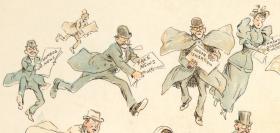The spreading fire of fake news by Margaret Van Heekeren (extract)
Historic newspapers show a long history of false reports taking hold in turbulent times.
Whether wildfire or pandemic, disaster offers a fertile paddock for the sowers of misinformation. It creates doubt and distrust at a time when people need truth and certainty.
Many blame social media but behind every false and malicious post is a human, or a human-programmed bot. Long before ‘post’ became a digital practice, those with a political, financial or merely mischievous intent traded in the lies and half-truths of fake news. Not that it has always been known as fake news.
Searches of digitised historic newspapers, such as those in the National Library of Australia’s Trove database, reveal the term ‘fake news’ was not in common usage until the middle of last century. It replaced ‘faked news’ as the preferred (and, perhaps, more accurate) term. But for much of last century and, in fact, for many centuries before, ‘false news’ was the appellation for fabricated reports purporting to be news.
...

Just as social media has furthered the spread of fake news in the twenty-first century, so too did earlier technological advancements. Mass printing from the 1600s saw fake news litter the columns of pamphlets and newspapers.
The invention of telegraphy in the 1800s enabled global sharing of news and information, offering speed and anonymity to news fakers. As the telegraph connected Australia throughout the 1850s, the Sydney Morning Herald New Year’s Day editorial of 1855 forecast the effect of that technology on false news: ‘It is instructive to see with what rapidity a great lie may gain the assent of the world … The telegraph will not, however, suffer a falsehood a long existence: its lightning speed soon overtakes the guilty error and condemns it. A few hours is the utmost duration of the best fabrication.’
The Herald was overly optimistic …
Subscribe to Openbook to read the full story.